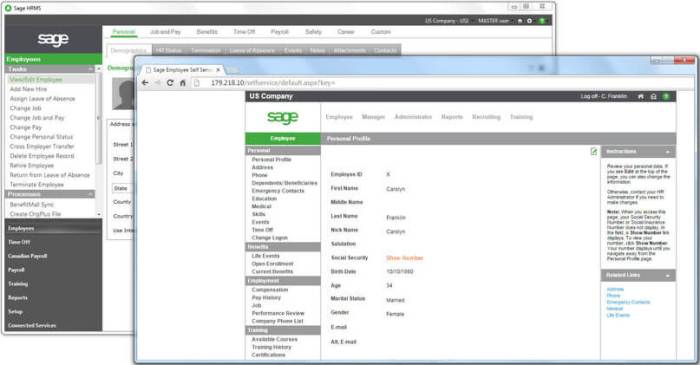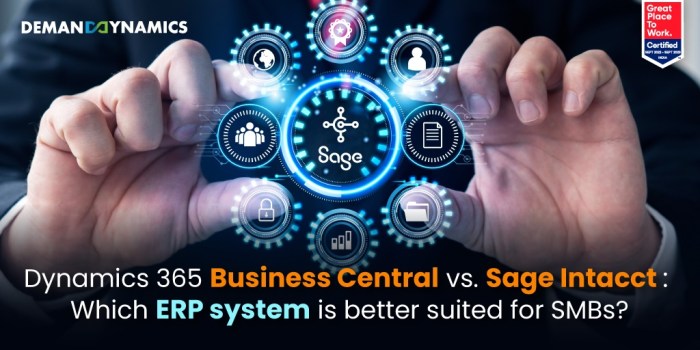Top Sage Intacct plans for small business accounting offer a range of solutions for growing businesses. This exploration delves into the various Intacct plans, examining their features, pricing, and suitability for different small business needs. We’ll analyze the core accounting features, comparing support and training options, and highlight essential considerations for choosing the right plan, especially regarding scalability and future growth.
Small businesses face unique accounting challenges. Understanding the different Intacct plans, their pricing structures, and specific features is crucial for selecting the right software. This comprehensive guide simplifies the process, providing valuable insights into choosing the ideal plan to meet your business’s specific needs and budget.
Sage Intacct Plans for Small Businesses: Top Sage Intacct Plans For Small Business Accounting

Source: top-sage-resellers.com
Sage Intacct offers a range of plans tailored to the varying needs and budgets of small businesses. These plans provide comprehensive accounting solutions, from basic bookkeeping to advanced financial reporting. Understanding the different options and their associated costs is crucial for selecting the right fit for a specific company.Small businesses often face challenges in managing their finances efficiently.
Sage Intacct plans address these challenges by offering cloud-based accounting software with features for invoicing, expense tracking, and financial reporting. The diverse plan options allow businesses to scale their accounting solutions as their needs evolve.
Intacct Plans Overview
Intacct offers several plans to accommodate various small business sizes and requirements. Each plan is designed with specific functionalities and pricing models. Choosing the right plan involves careful consideration of the company’s current accounting needs and anticipated future growth.
Plan Features and Functionalities
- Basic Plan: This plan provides the fundamental features for basic accounting tasks, such as invoicing, expense tracking, and basic reporting. It’s suitable for startups and small businesses with simple financial operations. Limited user access and reporting capabilities are typical of this tier.
- Pro Plan: This plan builds upon the basic plan, offering enhanced features like advanced reporting, multi-currency support, and inventory management. It’s a suitable choice for businesses requiring more comprehensive accounting tools. This plan may include increased user access and more sophisticated reporting options.
- Premium Plan: This plan provides the most extensive set of features, including advanced financial analytics, custom dashboards, and integration with other business applications. This is ideal for growing businesses with complex financial operations and a need for detailed financial insights.
Pricing Models
The pricing models for Intacct plans typically involve a monthly subscription fee. Different tiers are available, with each offering varying levels of access and functionality. Add-on services, such as dedicated support or custom integrations, are often available for an extra cost. Businesses can choose the plan that aligns with their budget and scale their needs accordingly.
Plan Comparison
| Plan Name | Monthly Fee | Core Features | Suitable Business Size |
|---|---|---|---|
| Basic | $XX – $YY (Example: $500 – $1500) | Basic accounting, invoicing, expense tracking, basic reporting | Startups, small businesses with simple operations, fewer than 5 users |
| Pro | $YY – $ZZ (Example: $1500 – $3000) | Advanced reporting, multi-currency support, inventory management, increased user access | Small businesses with growing operations, 5-20 users |
| Premium | $ZZ+ (Example: $3000+) | Advanced financial analytics, custom dashboards, integrations with other business applications, extensive user access | Growing businesses with complex operations, 20+ users, need for detailed financial insights |
Note: Specific pricing varies and should be confirmed directly with Sage Intacct. Examples provided are illustrative and may not reflect the actual fees. Monthly fees can fluctuate based on the number of users and the specific features required.
Intacct Features for Accounting Tasks
Intacct offers a suite of robust accounting features designed to streamline various business processes. Understanding the capabilities of each plan is crucial for businesses to select the right solution for their specific needs. This section explores the core accounting features, the support levels, and how they relate to specific accounting tasks.Intacct’s plans cater to different business sizes and needs, providing varying degrees of functionality.
Each plan offers a range of core accounting features like general ledger, accounts payable/receivable, and inventory management, but the extent of these features and associated reporting tools can differ. Crucially, the level of support and training varies with the plan, impacting a business’s ability to successfully implement and utilize the system.
Core Accounting Features
The core accounting features, such as general ledger, accounts payable, accounts receivable, and inventory management, are fundamental to any accounting software. The degree of sophistication in these features varies between Intacct plans. Some plans might provide more comprehensive functionalities, enabling businesses to handle complex accounting processes more efficiently. Businesses need to evaluate their current operational requirements to select a plan that best suits their needs.
Support and Training
Intacct provides different levels of support and training depending on the chosen plan. Higher-tier plans typically include more comprehensive support, including access to dedicated account managers, extensive training materials, and priority assistance. These plans might offer more in-depth support for complex accounting tasks. Businesses should consider their internal accounting expertise and the need for ongoing support when selecting a plan.
Examples of Accounting Tasks and Plan Support
Invoice processing, reconciliation, and budgeting are common accounting tasks. Intacct’s various plans provide differing levels of support for each task. A basic plan might offer limited invoice processing features, while a higher-tier plan would likely include more automated and comprehensive features. Similarly, reconciliation processes might be more manual in a basic plan, while more advanced plans provide automated reconciliation tools and reporting capabilities.
Specific Accounting Tasks and Plan Support
Intacct offers various features to manage accounting tasks efficiently. The features are crucial in invoice processing, reconciliation, and budgeting. The following table illustrates the key features available in each Intacct plan for handling diverse accounting tasks.
| Plan | General Ledger | Accounts Payable/Receivable | Inventory Management |
|---|---|---|---|
| Basic | Basic GL posting, reporting | Manual invoice entry, basic reporting | Basic inventory tracking |
| Pro | Advanced GL posting, customizable reports | Automated invoice processing, advanced reporting | Detailed inventory management, costing |
| Enterprise | Extensive GL features, real-time reporting | Complex AP/AR automation, advanced reporting | Sophisticated inventory control, forecasting |
Small Business Considerations and Best Practices

Source: demanddynamics.com
Choosing the right accounting software is crucial for small businesses, and Sage Intacct offers robust solutions. Understanding the specific needs of a small business, coupled with an appreciation for the software’s features, is paramount to a successful implementation. This section details key considerations for small businesses evaluating Intacct plans.Small businesses often face unique challenges in accounting, including managing growth and maintaining profitability.
Intacct’s adaptability to these needs, paired with user-friendliness, ensures a smooth transition for owners and staff. Successful implementation relies on proper support and training, ensuring everyone can leverage the system effectively.
Critical Accounting Needs for Scalability
Small businesses frequently outgrow initial accounting systems. Intacct plans must be chosen with scalability and growth potential in mind. This adaptability ensures the system can handle increasing transaction volumes and evolving business structures as the company expands. A good Intacct plan can be a critical asset in this process.
“Scalability is crucial for small businesses. An Intacct plan that can adapt to growth is an investment in the future.”
Importance of User-Friendliness and Ease of Implementation
Small business owners often have limited time and resources. User-friendly interfaces and straightforward implementation processes are essential for efficient adoption. Ease of use reduces training time and allows owners to quickly gain insights from the system, accelerating their ability to manage and grow the business. The software should empower, not overwhelm.
Role of Customer Support and Training, Top Sage Intacct plans for small business accounting
Intacct’s support and training resources are critical for successful implementation and ongoing use. Small businesses often benefit from personalized guidance and dedicated support, ensuring they can utilize the software to its full potential. Adequate training empowers staff to effectively manage their daily tasks within the Intacct system. A robust support network is crucial for minimizing disruptions and maximizing efficiency.
Essential Factors in Choosing an Intacct Plan
Careful consideration of specific needs is paramount. Small businesses must evaluate their current and projected accounting requirements. The choice should consider future growth potential.
- Scalability: A plan that can accommodate increasing transaction volumes, new employees, and expanded reporting requirements is crucial. Consider how the plan will adjust to potential growth over the next 3-5 years. If the company anticipates rapid growth, an Intacct plan with ample capacity is essential.
- Features: Evaluate whether the plan offers the necessary features for specific industry needs and business processes. A plan with features that align with specific business operations ensures the system can support day-to-day tasks efficiently. Examples include inventory management, order processing, and financial reporting.
- Support and Training: Access to quality support and training materials is vital. Consider the availability of online resources, tutorials, and dedicated support staff. Intacct plans that offer readily available support, including FAQs, knowledge bases, and dedicated support staff, are essential.
- Cost: Compare pricing models and features to ensure the plan aligns with the business’s budget. Cost should not be the sole deciding factor, but it is a vital consideration. Carefully evaluate the total cost of ownership, including software fees, implementation costs, and ongoing maintenance.
Final Conclusion
In conclusion, navigating the world of Sage Intacct plans for small businesses can be daunting, but this guide provides a clear framework for evaluating options. Understanding the diverse features, pricing models, and essential considerations like scalability is key. By carefully considering your business’s unique needs, you can select the perfect Intacct plan to support your accounting tasks and future growth.
Ultimately, the right choice ensures streamlined operations and positions your small business for continued success.